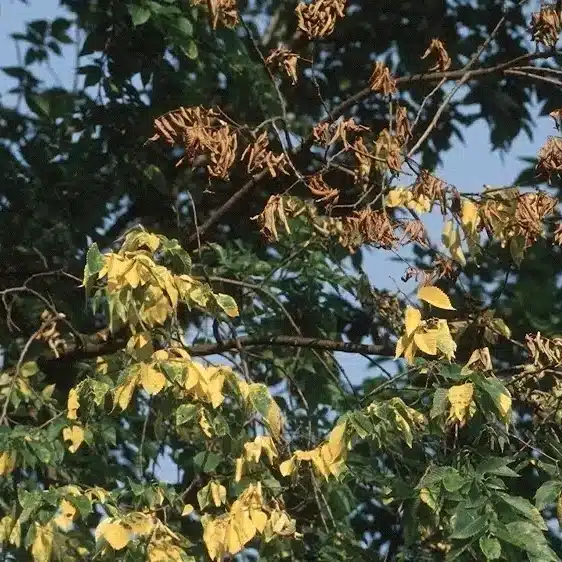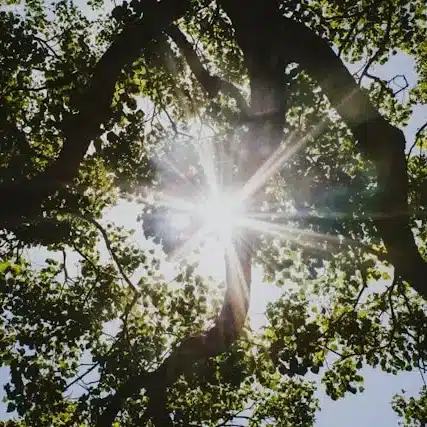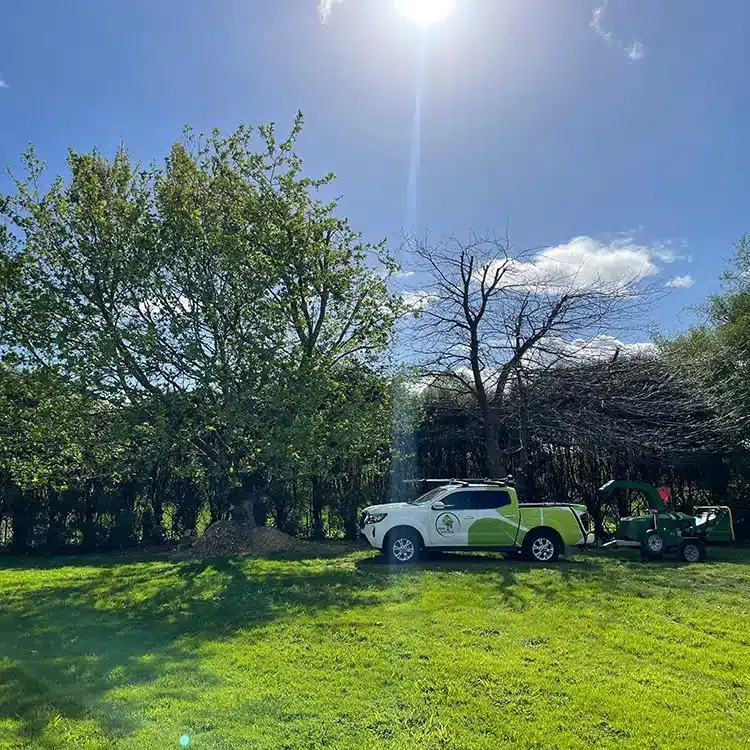It’s no secret that water is a crucial lifeline for all life forms, and trees and shrubs are no exception. Our planet’s changing climate often leads to long droughts that affect many types of trees, hurting them in ways we can see and ways we might not notice. As arborists in the beautiful but often dry landscapes of New Zealand, we often get asked how does drought affect trees. Let us walk you through the long-term effects of drought on trees and shrubs, and provide insights into how drought conditions can have a significant impact on these vital green organisms.
How Plants Use Water
Water is the lifeline of all plants, playing a major component in a range of roles that are vital to their health, growth, and development. Water use in plants is like a well-orchestrated song—everything works together in a balanced way to help the plants grow and stay alive.
Water in plants works like air in a balloon, keeping the plants firm and upright. If there’s not enough water, the plants will wilt, just like a deflated balloon. Water also helps keep the plant cool, sort of like how sweating helps cool us down.
Water’s journey through a plant starts in the tiny root hairs, which act like little straws sucking up water from the soil. This water then travels through the plant’s own plumbing system, called the xylem, reaching all the parts of the plant.
Once in the leaves, water mixes with sunlight and air to make food for the plant and give off oxygen. It also helps move important nutrients from the soil throughout the plant to help it grow and stay healthy.
Water doesn’t just stay in the plant, though. Some of it escapes back into the air through tiny openings in the leaves called stomata. This loss of water helps pull more water up from the roots and keeps the plant cool, kind of like how sweating works for us. It also keeps the air around the leaves just right for making food. So, you can think of water as the plant’s lifeblood; it’s essential for its health and survival.

Drought Effects on Plants: A Chain Reaction of Stress
Drought and dry soil conditions can affect how plants use water, which sets off a whole chain reaction of problems for the plant.
When there’s not enough water in the soil, the plant can’t suck up as much water through its roots. This makes the plant go into a sort of “water-saving” mode. It closes tiny openings in its leaves to stop water from escaping, but that also means the plant can’t breathe properly and make food.
This lack of water starts causing problems all over the plant. It might start to wilt, like a flower in a vase that hasn’t been watered. Its growth might slow down because water is needed for the cells to grow and divide. Over time, the plant can get weak and sick, making it an easy target for bugs and diseases.
In really bad cases, the whole water system in the plant can break down, like pipes getting clogged in your house. This can cause big parts of the plant, or even the whole thing, to dry up and die.
So, drought doesn’t just make a plant thirsty. It can stunt its growth, make it weak, and even kill it. It’s like a domino effect, where one problem leads to another, all started by a lack of water.

Long-Term Side Effects of Drought Stress in Trees
Long-term drought stress weakens trees’ root systems and the tree’s fine roots over time, reducing their growth and vitality. Roots become shallower as they seek out water near the surface, leaving root systems and trees less stable. A prolonged drought or lack of water also reduces the tree and root system or the tree’s immune response, making it more susceptible to diseases and insect attacks.
Other Visible Symptoms of Drought: A Plant’s Silent SOS
While the effect of a drought on trees’ internal structure often goes unnoticed, the plant exhibits various visual cues signalling water stress. These visible symptoms can manifest in different ways, depending on the plant species and the severity and duration of the drought.
Wilting or curling of leaves is one of the first visible signs. This happens as the plant begins to lose more water than it can absorb. Without enough water, the turgor pressure from water movement keeps cells rigid and is lost, leading to drooping or wilting leaves. In some cases, leaves may also curl inward in an attempt to reduce their surface area and slow down water movement and transpiration.
Another common symptom is early leaf drop or premature leaf fall during the growing season. This is an adaptive response, where the plant sheds leaves to reduce its overall water demand growing season. However, this can impact the plant’s ability to photosynthesize and produce food during the growing season.
In severe or prolonged drought conditions, you may observe branch dieback. The plant, in its struggle to get water deficit to survive, starts to sacrifice its extremities, cutting off the water supply to some branches. As a result of moisture stress, these branches dry out and die.
Drought can also cause changes to the bark of trees. The shrinking of the water molecules in the tree’s tissues from dehydration can cause the bark to crack or the bark cracks to become loose. This many bark cracks and damage not only affect the tree’s appearance but also expose it to other environmental threats, such as infectious diseases and pests.

Secondary Effects: Drought’s Domino Effect
Drought doesn’t just hurt plants by drying them out; it can also cause a whole bunch of other problems. Think of it like a plant getting a cold and then catching more serious illnesses because it’s weak.
When plants are thirsty and stressed, they send out chemical signals kind of like an SOS. Some bugs, like bark beetles, can pick up on this distress call. They’re attracted to these drought-stressed plants and trees and can bore into the bark, bringing in diseases that can hurt or even kill the tree.
The dry, cracked bark that comes with drought also gives other nasty stuff like fungi and bacteria an easy way in. Once they get inside, they can cause all sorts of diseases that make the healthy tree get even sicker.
So, drought is not just about plants getting thirsty. It can be a gateway to other problems that can pile on and make things much worse. It’s like one thing leading to another, all starting with the root system and lack of water.
Consequences on Photosynthesis: The Throttle on Life’s Engine
Photosynthesis is the process that drives life in plants, converting sunlight, water, and carbon dioxide into glucose, which serves as the plant’s food, and oxygen. However, this crucial process is significantly affected by drought.
Water is not just a raw material for photosynthesis—it also maintains the plant’s structure and cools the plant through transpiration. When a plant is water-stressed, or drought-stressed, it responds by closing its stomata to prevent water loss. However, this stomatal closure also limits the intake of carbon dioxide, a necessary component for photosynthesis. This means that the plant’s food production slows down or even stops.
Moreover, the energy produced by photosynthesis is not just used to fuel plant growth and reproduction—it’s also used to fend off diseases and pests and to heal injuries. So, when photosynthesis efficiency is reduced, the plant’s overall vitality and survival potential are compromised.
Thus, the impact of drought on photosynthesis can create a vicious cycle. It slows down the plant’s growth and reproduction, reduces its defensive capabilities, and in severe cases, may lead to the plant’s death.
Growth Responses: Nature’s Hard Choices
Drought significantly alters the growth patterns of trees and shrubs. When a tree is faced with drought, with limited water resources, the plant has to make difficult trade-offs—prioritising survival over growth. This often results in drought and stunted tree growth, both above and below the ground.
Above ground, you’ll likely notice fewer new leaves and branches. Leaf growth, in particular, is often drastically curtailed since leaves are the primary site of water loss. Reducing leaf numbers is a strategic move to minimise water loss through transpiration.
Below ground, the scenario for many tree species is similar. Root growth also slows down, as resources and root systems are conserved. However, the existing roots may grow longer or wider, or even change their orientation, as they try to explore deeper or broader soil regions in search of moisture.
Over time, these changes in soil type can significantly impact the overall shape and size of the tree or shrub. While it may help the plant survive the drought, it can also lead to some long-term effects and changes in its structural stability and productivity.

Suberin and Lignin Formation in Roots Under Drought Conditions: Double-Edged Sword
In response to drought stress, plants often increase the production of two compounds in their roots—suberin and lignin. These compounds act as barriers, making the roots more resistant to water loss and pathogen invasion.
Suberin is a waxy substance that waterproofs the roots, reducing water loss. Lignin is a complex organic polymer that strengthens the cell membranes and walls, making them more rigid and less permeable. Together, these substances make the tree roots hardier and less likely to be affected by drought damage and better equipped to withstand drought if conditions persist.
However, this increased resilience comes at a cost. The more suberised and lignified fine roots are, the less efficient the feeder roots are at absorbing water and nutrients from the surrounding soil. The protective layer created around fine roots by these compounds effectively keeps soil moisture and blocks the entry of water and nutrients feeder roots, making it difficult for the plant to nourish itself. So while the plant might be better equipped to survive a drought, its overall health and growth potential could be compromised in the long run.
How To Protect Your Trees From Drought: Proactive Care and Planning
While the effects of drought can be severe, there are steps you can take to protect your trees and shrubs and minimise damage. These include both immediate actions and long-term planning.
Firstly, prioritise both deep watering and over-soaking when watering your trees and shrubs, especially during dry spells. Focus on deep watering, not deep soaking, which encourages established trees’ roots to grow downwards, where the soil retains more moisture.
Using mulch around your plants can also be beneficial. Mulch helps to reduce water evaporation from the soil surface, keeping the soil moist for longer. It also suppresses weed growth, reducing competition for water resources.
Long-term planning should include the implementation of a drought-tolerant landscape design. Consider using native, drought-resistant plants and species of trees that are adapted to your local climate and soil conditions. These plants and trees will be better equipped to survive dry conditions and will require less watering.
Remember, protecting our green companions from drought and other pests is not just about their survival. It also contributes to a healthy, thriving ecosystem that benefits us all.
Tree Root Decomposability and the Role of Roots for Organic Matter Formation and Persistency
Under drought conditions in sandy soils, the decomposition rate of tree roots slows down, contributing to the build-up of organic matter in the soil. While this can benefit soil health, the accumulation of undecomposed roots in sandy soils might also lead to changes in soil structure, water availability and nutrient availability over time.
As we continue to face the challenges brought on by climate change, understanding the impact of drought on tree health and our green companions becomes increasingly vital. Through care, attention, and adaptive gardening practices, we can help our trees and shrubs weather these dry spells, ensuring their—and our—survival for generations to come.

Navigating Drought’s Challenges – A Comprehensive Approach to Protecting Our Trees and Shrubs
In conclusion, the long-term effects of drought on trees and shrubs present a complex and multifaceted challenge that extends far beyond simple dehydration. From the internal mechanisms of water utilisation to the intricate chain reactions of stress, drought has the potential to weaken, stunt, and even kill plants. The altering of growth patterns, root decomposition, and increased susceptibility to diseases and pests adds layers of complexity to this environmental problem, particularly in regions prone to extended dry periods, like New Zealand.
Yet, there is hope. Through a combination of understanding, proactive care, strategic planning, and responsible landscaping practices, we can mitigate the impacts of drought on our green companions. The lessons contained within this deep dive guide serve as a testament to the resilience of nature and the potential of human stewardship. By embracing both immediate actions and long-term strategies, we can contribute to a sustainable and thriving ecosystem, ensuring the beauty and vitality of large trees in our landscapes for generations to come. Whether you’re an arborist, a gardener, or simply someone who appreciates the serenity of a lush environment, the care and preservation of our trees and shrubs is a shared responsibility that benefits us all.







